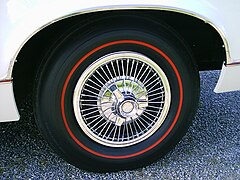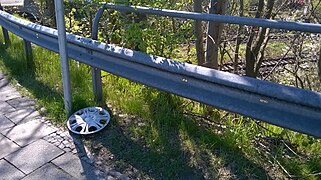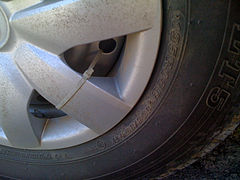
An axle or axletree is a central shaft for a rotating wheel or gear. On wheeled vehicles, the axle may be fixed to the wheels, rotating with them, or fixed to the vehicle, with the wheels rotating around the axle. In the former case, bearings or bushings are provided at the mounting points where the axle is supported. In the latter case, a bearing or bushing sits inside a central hole in the wheel to allow the wheel or gear to rotate around the axle. Sometimes, especially on bicycles, the latter type of axle is referred to as a spindle.
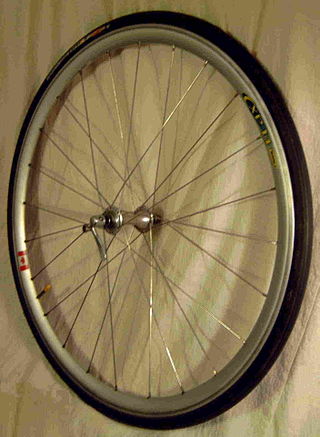
A bicycle wheel is a wheel, most commonly a wire wheel, designed for a bicycle. A pair is often called a wheelset, especially in the context of ready built "off the shelf" performance-oriented wheels.
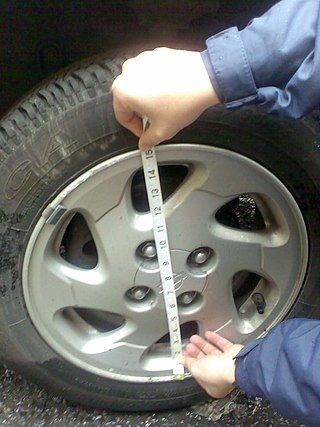
The wheel size for a motor vehicle or similar wheel has a number of parameters.

The AMC Spirit is a subcompact car sold by American Motors Corporation (AMC) from 1979 through 1983. Replacing the AMC Gremlin, the Spirit was available in two different body styles, both of which were two-door hatchbacks – but neither was marketed as such. Instead, AMC offered a restyled Gremlin either as a "Spirit Kammback" or "sedan", while an additional model with a more gently sloping rear was introduced as the Spirit liftback or "coupe". Due to budget constraints, the Spirit shared the Gremlin's platform – its floorpan, powertrains, and many other parts were carried over. AMC also offered a four-wheel drive cross-over version using the Spirit's bodywork, marketed from 1981 through 1983 model years as the AMC Eagle SX/4 and Eagle Kammback. Spirits were manufactured by AMC in both Wisconsin and Ontario, as well as under license by V.A.M. in Mexico where they retained the Gremlin name on the restyled models.

The AMC Concord is a compact car manufactured and marketed by the American Motors Corporation for model years 1978–1983. The Concord was essentially a revision of the AMC Hornet that was discontinued after 1977, but better equipped, quieter, and smoother-riding than the series it replaced. It was offered in four-door sedan, two-door coupé, three-door hatchback, and five-door station wagon configurations. The Concord was AMC's volume seller from the time it appeared until the introduction of the Renault Alliance.
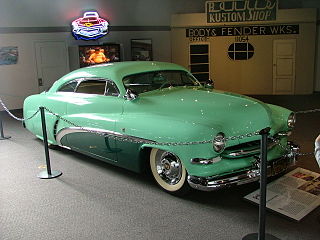
A custom car is a passenger vehicle that has been either substantially altered to improve its performance, often by altering or replacing the engine and transmission; made into a personal "styling" statement, using paintwork and aftermarket accessories to make the car look unlike any car as delivered from the factory; or some combination of both. A desire among some automotive enthusiasts in the United States is to push "styling and performance a step beyond the showroom floor - to truly craft an automobile of one's own." A custom car in British according to Collins English Dictionary is built to the buyer's own specifications.

The Dodge Caliber is a compact hatchback manufactured and marketed by Chrysler's Dodge division from model years 2007 to 2012, replacing the Dodge Neon and Chrysler PT Cruiser.
The spinner on automobile wheels historically refers to knock-off hub nuts or center caps. They may be the actual, or intended to simulate, the design used on antique vehicles or vintage sports cars. A "spinner wheel" in contemporary usage is a type of hubcap or inner wheel ornament, that spins independently inside of a wheel itself when the vehicle is in motion and continues to spin once the vehicle has come to a stop.
DRAG-U-LA, along with the Munster Koach, was one of two cars on the television show The Munsters designed by prolific show car designer Tom Daniel while working for George Barris and Barris Kustom Industries.

The rim is the "outer edge of a wheel, holding the tire". It makes up the outer circular design of the wheel on which the inside edge of the tire is mounted on vehicles such as automobiles. For example, on a bicycle wheel the rim is a large hoop attached to the outer ends of the spokes of the wheel that holds the tire and tube. In cross-section, the rim is deep in the center and shallow at the outer edges, thus forming a "U" shape that supports the bead of the tire casing.

The artillery wheel was a nineteenth-century and early-twentieth-century style of wagon, gun carriage, and automobile wheel. Rather than having its spokes mortised into a wooden nave (hub), it has them fitted together in a keystone fashion with miter joints, bolted into a two-piece metal nave. Its tyre is shrunk onto the rim in the usual way, but it may also be bolted on for security.
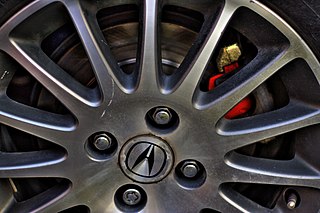
A lug nut or wheel nut is a fastener, specifically a nut, used to secure a wheel on a vehicle. Typically, lug nuts are found on automobiles, trucks (lorries), and other large vehicles using rubber tires.

Wire wheels, wire-spoked wheels, tension-spoked wheels, or "suspension" wheels are wheels whose rims connect to their hubs by wire spokes. Although these wires are considerably stiffer than a similar diameter wire rope, they function mechanically the same as tensioned flexible wires, keeping the rim true while supporting applied loads. The term suspension wheel should not be confused with vehicle suspension.

The Ford Crown Victoria Police Interceptor is a four-door, body-on-frame sedan that was manufactured by Ford from 1992 to 2011. It is the police car version of the Ford Crown Victoria and was the first vehicle to use the Ford Police Interceptor name.

In the automotive industry, alloy wheels are wheels that are made from an alloy of aluminium or magnesium. Alloys are mixtures of a metal and other elements. They generally provide greater strength over pure metals, which are usually much softer and more ductile. Alloys of aluminium or magnesium are typically lighter for the same strength, provide better heat conduction, and often produce improved cosmetic appearance over steel wheels. Although steel, the most common material used in wheel production, is an alloy of iron and carbon, the term "alloy wheel" is usually reserved for wheels made from nonferrous alloys.

The eleventh generation of the Ford Thunderbird is a two-seat convertible manufactured and marketed by Ford from 2001 to 2005 for model years 2002 through 2005. It followed a five-year hiatus of the Thunderbird after the 1997 discontinuation of its tenth generation.

A center cap, or centercap is a decorative disk on an automobile wheel that covers a central portion of the wheel. Early center caps for automobiles were small and primarily served the purpose of keeping dirt away from the spindle nut and wheel bearings of vehicles. Center caps are often found on new cars to hide the lug nuts, and/or the bearing. Center caps are a type of hubcap, the other primary type being wheel covers. Some modern center caps are retained to the wheel using spring clips, while others are retained by the wheel lugs or other threaded fasteners.
The VAM Lerma is an automobile that was designed and manufactured by Vehiculos Automotores Mexicanos from 1981 to 1983. The Lerma shared parts with other vehicles by VAM's license partner American Motors (AMC) to reduce manufacturing costs. It was VAM's top-of-the-line flagship model after the discontinuation of the Classic (Matador) line in 1976. The VAM Lerma was unusual in offering a hatchback design focused at the top-end luxury market. The model was an indirect replacement of the VAM Classic and to some extent the VAM Pacer lines.
A centerlock wheel is a type of automobile wheel in which the wheel is fastened to the axle using a single, central nut, instead of the more common ring of 4 or 5 lug nuts or bolts.






